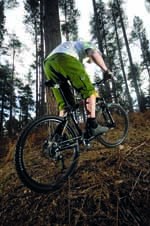 FRAME
FRAME
For 2007, Trek has reduced the frame weight of the 6000 by over 100g thanks to thinner-walled tubing and new dropouts. Top and down tubes take their design cues from nature, using buttressing (as seen at the base of tree trunks) to support the extended seat tube and head tube. Elliptical chainstays and seatstays are taller than they are wide, which is not ideal when it comes to comfort, as structures resist bending best along their longest axis. A wishbone-style construction at the top of the seatstays does nothing to improve the vertical compliance.
SUSPENSION
Like the other RockShox forks fitted to the Kona and Specialized, the Dart 2s on the Trek have adjustable rebound damping. Another nice touch is the lockout mechanism. Rather than being a mechanical switch, it is part of the damping circuit and, if accidentally left locked, large bumps overpower it — preventing internal damage.
WHEELS
Using an offset spoke bed enables Bontrager to even up spoke tension in its wheels. This makes them less prone to buckling as an evenly tensioned wheel is a strong wheel. The rubber also comes from the same brand, and while the square-block tread pattern is simple, it’s a good all-round tread. Longitudinal ridges running around the tyre add some directional stability.
GROUPSET
Avid’s Juicy 3 brakes are a stand-out component with the most ergonomically satisfying action thanks to the unique position of the lever blade pivot. The drivetrain proved reliable, but it is always disappointing to see a square-taper chainset at this price as they are not as strong as two-piece — or splined — designs.
COMPONENTS
More parts from the Bontrager box complete the Trek. An oversize seatpost and sparsely padded racy saddle do you no favours on the comfort front, while the overly long stem stretches the rider too much for our liking.
PERFORMANCE
The layout of the Trek is enjoyable, but let down by an over-long stem. Considering the decent length top tube, a stem some 20mm shorter could be used without upsetting the balance of the bike and would make lofting the front wheel a whole lot easier. Where the Trek loses marks to the best bikes is in the ride: the rear end is too stiff. This makes for a very fast bike, responsive to power input, but every rock, root and pebble can be felt. Even small undulations vibrate through the soles of your feet.
VERDICT
Trek’s new 6 series frame is a vast improvement. A longer cockpit makes for a very balanced riding position, and the forks absorb trail obstacles well. However, the 6000 cannot cut it in comfort terms as even high frequency vibrations, such as gravel, are felt by the rider. A shorter stem would help and a padded saddle would improve comfort, but it will never live up to the standard set by the top three.
MBR RATING: 7/10



